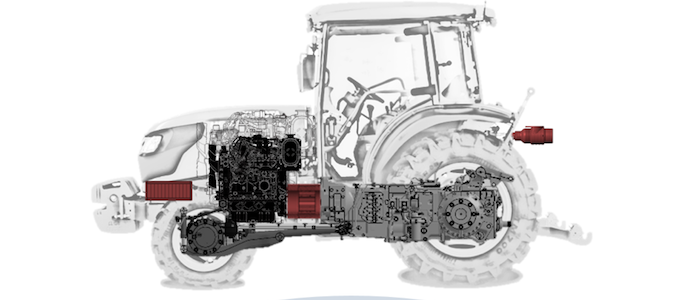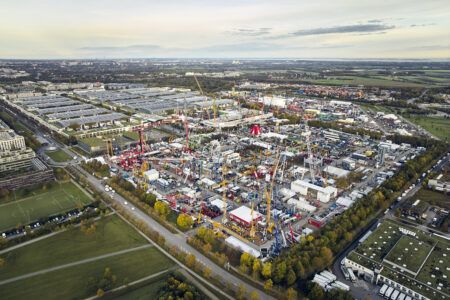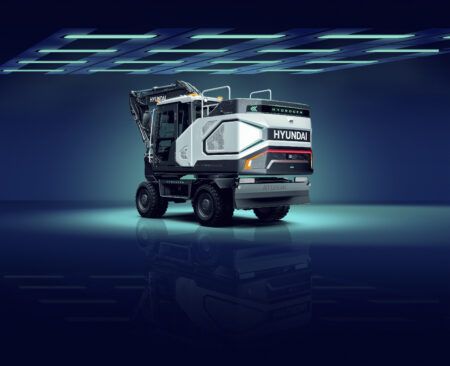Authors
- MSc Thomas Woopen, AVL Tractor Engineering Germany
- Dr-Ing Hagen Adam, AVL Tractor Engineering Germany
- Dipl-Wirtsch-Ing Armin Gronewold, AVL Tractor Engineering Germany
- Dr-Ing Stephan Hammes, AVL Tractor Engineering Germany
Abstract
Battery electric vehicles are becoming more and more important in commercial vehicle technology. Replacing the conventional internal combustion engine with an electric drivetrain without affecting the vehicle structure is the most applied concept. So it is realized, for example in wheel loaders, forklifts and tractors. In addition to these practical implementation variants, other solutions must be considered which can also represent added value, for example in terms of environmental protection depending on the intended use of the vehicle.
Motivation
While regular emission violations are being proclaimed in various major European cities, scenarios are increasingly being considered as to how the burden of combustion engines can be reduced. This is especially concentrated in conurbations and affects diesel-fueled engines. The environmental badge introduced in Germany in 2008 already serves this purpose, while there are still discussions going on about total bans for diesel driven vehicles in defined sub-areas.
The focus is on the automotive industry, whereby various commercial vehicles such as the tractors of municipal utilities are not considered and exempted from passing bans by the Bundesimmissionsschutzgesetz [1].
Nevertheless, there is an enormous potential for electrification, especially in the municipal power classes, which can already be covered with today’s technology. It is exactly those performance classes, in which a vehicle traction power of 100hp is typical, that are also found in the cultivation of special crops such as vineyards and orchards.
Although this is considered less due to the rural situation with the particulate matter in metropolitan areas, here the cultivation of products that are subject to the organic label, the sustainability of the entire process chain can be underpinned by cultivation, nurture or harvest by lower emissions or even emission-free. The path to full electrification can be broken down into three main stages, as shown in figure 1.

The three steps from mild hybridization through full hybridization to the battery electric vehicle are based on each other in terms of development effort and system costs. With each additional step, more functions can be implemented, some of which are already known today in the automotive industry. The optimization in emissions also comes into effect with each further expansion stage.
Integration of a mild-hybrid system
The basic idea of the mild hybrids is the downsizing of the diesel powered internal combustion engine. While tractors in higher power classes are only allowed to be sold with the European emission level 4 since 2014, vehicles classified in vehicle category T2 are only affected by emission level 3B. This category includes most municipal and special crop tractors.
With the beginning of the year 2022 the levels will be updated, so that with the introduction of the emission level 5 stricter limit values also apply in this level. The key point is that T2-interim vehicles with a diesel output of less than 56kW (76hp) are to be given special consideration, as no distinction is made between hydrocarbons and nitrogen oxides for this performance range.
It is likely that only an oxidation catalytic converter and a diesel particulate filter will be used to maintain the total particle count. An additional SCR is not required. This point can be addressed for vehicles that have an output power of more than 56kW, by downsizing the diesel engine below the limit of 56kW and providing the remaining power of up to 20kW via an electric motor in parallel with the diesel engine.
It can be assumed that the reduction of the diesel engine will provide enough space to accommodate the electric motor, the power electronics and the required battery also under the hood so that the rest of the structure of the vehicle, as shown schematically in figure 2, remains unchanged.
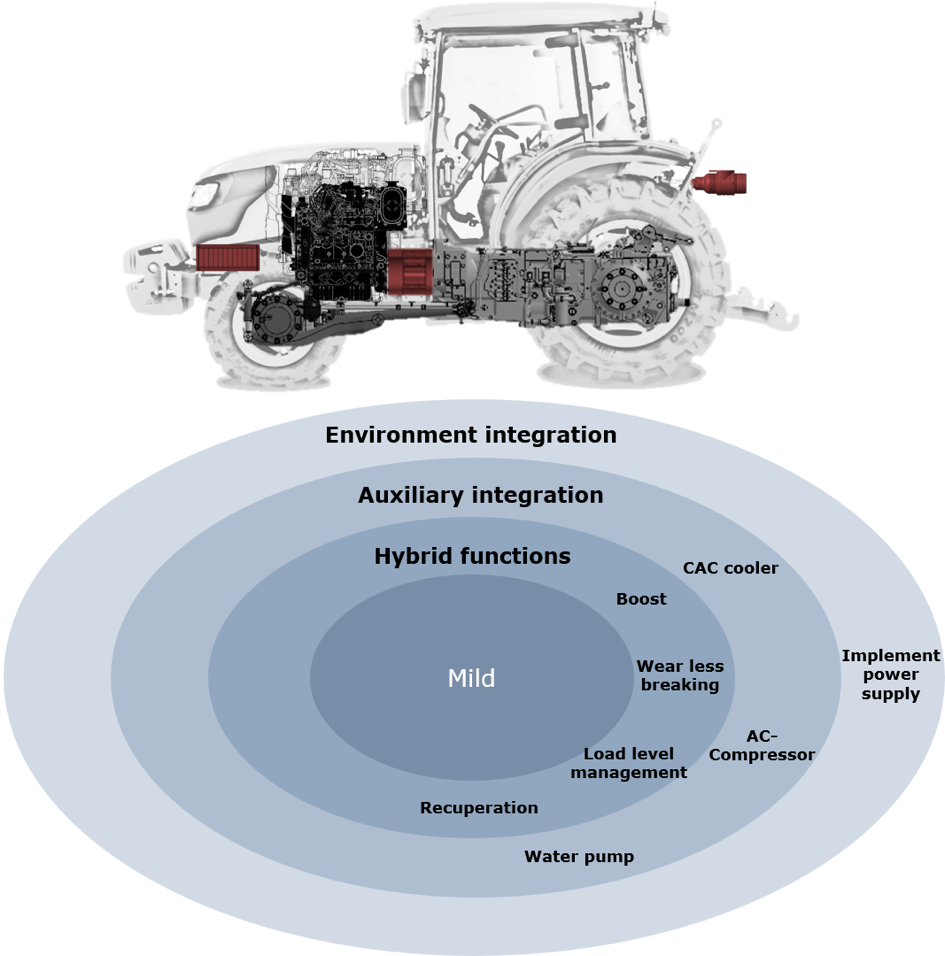
The mentioned battery can be realized relatively small in this configuration with a capacity of about 6kWh. The main task of the energy storage is to gain energy in case of braking in the sense of recuperation or in lower load points of the diesel engine. For those operating points in which a traction power of more than 56kW is needed, a battery-powered boost can be superimposed on the system via the electric motor, so that no functional disadvantages will arise for the user in comparison to the conventional tractor.
The vehicles of the questioned performance class are particularly suitable for such a system, since working under continuous full load is more of an exception in this segment. Beyond the mentioned basic function, the hybrid system can also be used to protect the vehicle brakes by slowing down the vehicle over the electrical power path or at least to keep it at a constant speed for longer downhill drives, as they often occur both in the communal area and for example in viticulture.
Additionally, it is conceivable to build up on this system and complete the electrical power path in excess of the traction driveline, so that the typical auxiliary consumers of the diesel engine are electrically controlled independently instead of being propelled by the belt drive. Without overloading the electrical system, the cooling water pump or the charge air cooler can be controlled as needed.
The overall efficiency of the vehicle is optimized by not controlling the auxiliary drives proportional to the engine speed but depending on the engine load. In addition, an electrification of the air conditioning system is conceivable, so that the components of the air conditioner can be fully integrated into the cabin. Going beyond the system limits of the vehicle, additional electrical power can be supplied to implements for precision drives as demonstrated by Fendt in the run-up to Agritechnica 2017.
In this context, the low proportion of electrical power has an effect, since such a system can be realized with an electrical rated power of up to 20kW in the low-voltage range [2] of for example at 48V. An additional voltage conversion for the operation of a 48V powered implement is not necessary.
Extension to a full hybrid system
Depending on the available installation space, the mild-hybrid system can be supplemented into a full-hybrid system by integrating further components. It is assumed that in addition to the battery capacity that is needed to cover the power peaks, further battery modules can be integrated into the vehicle structure.
A system structure like this allows additional functions, such as a short-term fully electric operation. While this is used in the automotive industry primarily in urban transport, where it is referred to as ‘gliding’, the importance of such an application can be found especially in today’s fully electric loaders [3].
For indoor applications – such as feeding or storage work – the diesel engine can be deactivated and the vehicle is switched to the emission-free drive. This function can be supplemented by an additional electric motor at the same power level, which can be designed as a fully electric front-axle drivetrain based on the limited space available as shown in figure 3.
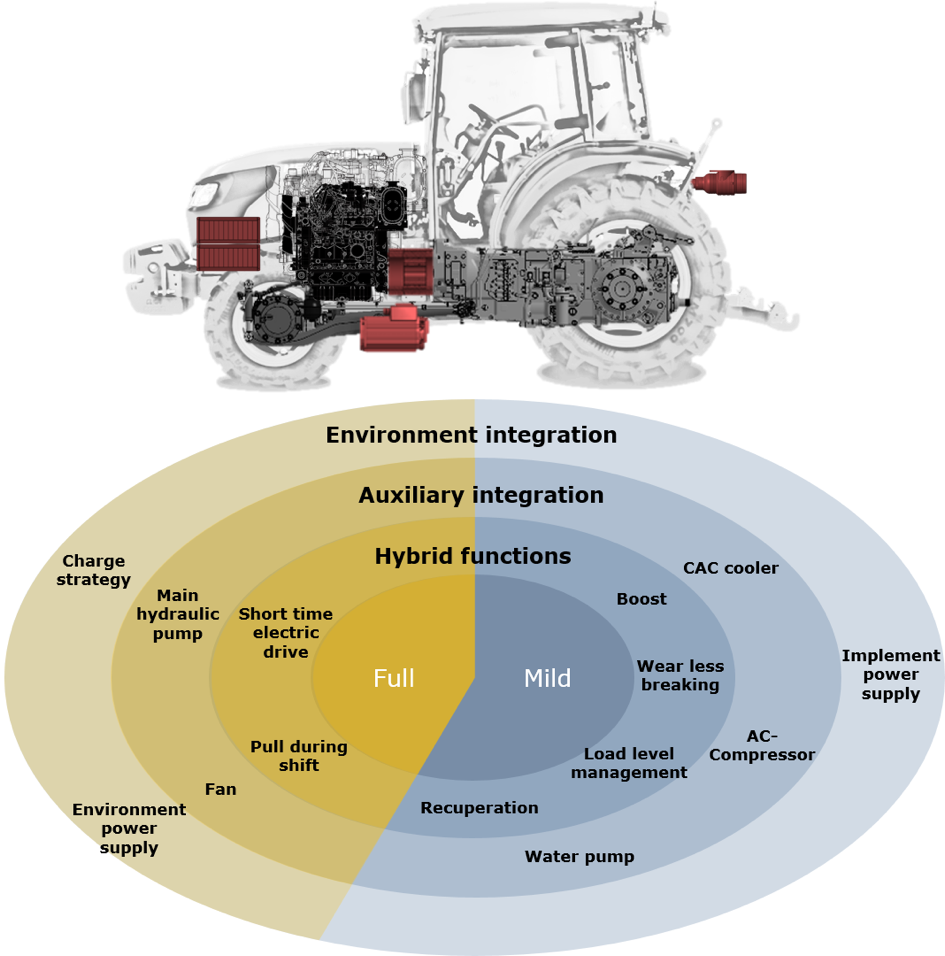
This arrangement of the second electric drive unit allows two further functions, in addition to battery only operation. The function of the shift assistance builds up on the emission-free operation and promotes primarily the driving comfort. For both manual and automated transmissions, the gear shifting period during which the drive clutch is opened and the mechanical drive path is interrupted, the drive torque can be maintained via the parallel electric drivetrain. The energy required for this does not have to be provided by the battery, but rather can be generated directly from the diesel engine via the electric motor located near the engine.
On the one hand the drop in speed as a result of the traction interruption can be reduced; on the other hand this can have a supporting effect on the actual gear shift so that it can be carried out more quickly and with a lower impact on the shifting components.
Likewise, a front-axle electric powertrain can have a significant impact on the agility of the vehicle by applying additional electrical boost power to the front axle when cornering by pulling the vehicle around the corner via the pull-in-turn function. Positive changes are already possible by adjusting the pre-run to the current driving situation [4].
By expanding the system with further storage capacity and by another electric drive unit, which can act as a second generator across both axle drives, additional applications with a higher power reduction are conceivable in full hybrid depending on the driving situation.
A demand-driven control of the cooling fan or of the main hydraulic pump not only enables the operation of these components in more efficient performance ranges. In addition, the reduction of the belt drive has a positive effect on the placement options of the components, so that all positions of auxiliaries follow their function and are not determined as in today’s operation by the power source.
The increased battery capacity also allows the stationary power supply of electrical components, so that the vehicle can provide external equipment at standstill as well as emission-free in the function of an emergency generator. Working in self-contained halls or welding in the field are only a part of possible applications. For this purpose, it is necessary to charge the battery via a charging point, so there is no need to provide the energy by the diesel engine.
System conversion to fully electric tractor
In order to realize the step to the all-electric battery-powered tractor without a complete new development, manufacturers such as Fendt [5] or Escorts [6] used comparable concepts. Each BEV was mounted on an existing vehicle, only the components associated with the diesel engine were replaced by a central electric motor and a correspondingly large battery unit including power electronics.
The installation space under the hood was therefore replaced one by one. The electric motor is connected to the same gearbox, which is installed in the diesel-powered tractor, so that the electric motor is supported by the transmission ratio. It is important to know that the overall structure of the vehicle does not need to be adjusted so that the vehicle price can be controlled through the use of existing components.
Although the transmission can be omitted in its function by the use of a corresponding electric motor, it must be taken into account that the transmission not only transmits the traction power. Rather, the transmission is designed in this vehicle class as a structural component, so that it serves as a support component for all other subsystems like the rear axle, the cabin or the front axle.
The omission of the transmission at the expense of further battery packs, as illustrated in figure 4, is therefore associated with a redesign of the vehicle structure.
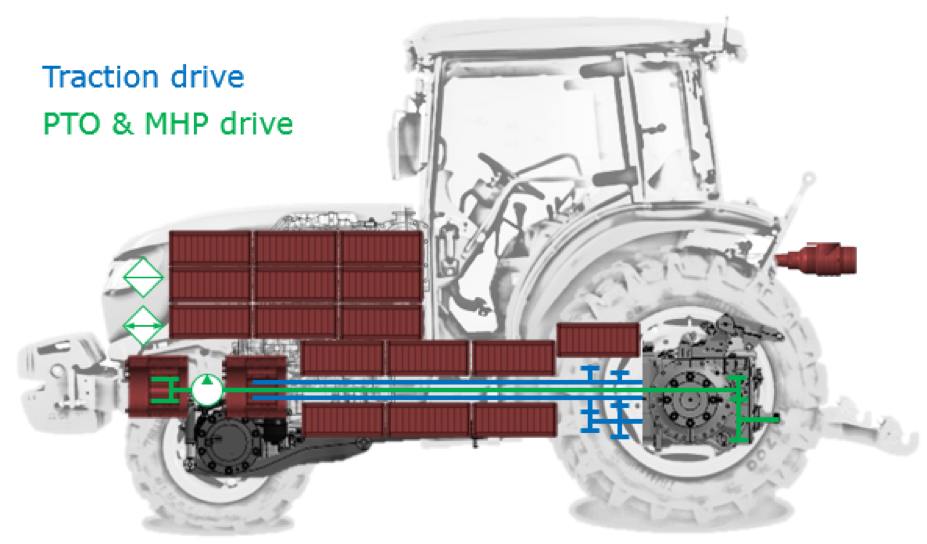
As with the concepts of Fendt or Escorts, the installation space under the hood is used for the electric power units. Additional space is created in the area of today”s transmission to install more batteries. Depending on the vehicle configuration it might be advisable to support the system by a 2-speed gearbox installed between the electric motor and the conventional rear axle.
Depending on the maximum speed of the vehicle, the electric drive is perfectly sized and the drive of a possibly driven front axle can be realized by the mechanical transmission stage. Independent of the traction drive a smaller electric motor drives both the main hydraulic pump and the PTO shaft. Both can be operated independently of the vehicle speed in their ideal speed ranges. This configuration even allows a temporary limited full utilization of traction and hydraulics or PTO. It should be noted that such a behavior has a significant effect on the battery life and the energy storage must also be designed for larger discharging powers.
This structure differs from existing vehicles not only by the larger battery capacity. In already presented systems, the center of gravity of the vehicle is shifted strongly toward the front axle by the heavy battery pack installed directly on the front. This redistribution can negatively affect the handling and ballasting of the vehicle. To counteract such influences, the center of gravity displacement can be compensated by placing most of the batteries between the axles. The potentially lighter components, such as the drives and the hydraulic units, are installed in the front spaces.
However all configurations in which an all-electric drive is integrated based on an existing vehicle have the disadvantage that the wheel loads and the components are not ideally matched with each other. In addition, costs arise due to a corresponding system structure, which can hardly be justified by the given functions.
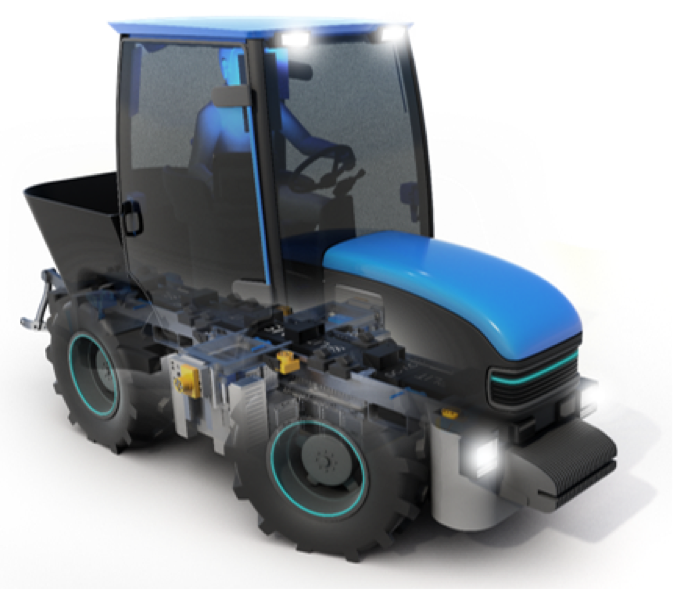
In contrast, disengaging from the conventional small tractor structure, exemplified in Figure 5, allows the creation of significant machine added value, so that the economics of a fully electric system are to be reconsidered. It is not limited to one type of a machine, but rather to combine the cost-driving components, such as the electric drives, batteries or power electronics, in a base chassis, which can be used both as a basis for a tractor and for a harvesting or maintenance machine on the same power level.
Additional to the electrical power, the required hydraulic and pneumatic power is provided by the chassis so that by expanding this basic component by system implements for each application, the ideal matching vehicle configuration can be created. This avoids that, especially in seasonal work, the economic efficiency of the system is clouded by insufficient capacity utilization, but the cost-intensive components are used across applications.
The functional added value, as it is already clear today with combustion engine driven equipment carriers, can be further optimized by the integration of the electrical system. The flexibility of the electrical power take-off enables new possibilities in the vehicle configuration. A fixed internal combustion engine with non-portable shafts for transmitting mechanical power thus no longer prevents the user from adapting the vehicle ideally to the pending application.
Conclusion
In summary, it can be explained that, despite the increasing number of limitations that are currently emerging, the diesel engine will remain an integral part of the tractor industry for the near future. By manageable adjustments in the course of a mild-hybrid solution or a full-hybrid solution, the power of the internal combustion engine can be reduced both for the benefit of the environment and for the use of new functional potentials.
In this case, the system costs can be kept within an economic level, while the integration of such a system does not require a complete new development of the vehicle and can also rely on known structures for the user. This should always be considered as an important factor in the market implementation of electric mobility in municipal and agricultural engineering.
At the same time, fully electric battery-operated solutions should also be pursued. A construction of such systems based on current vehicle structures already shows the first possibilities of this technology, but it is far from exhaustive.
In addition, the cost-effectiveness of such systems must be questioned if, apart from emission-free operation, the vehicle can have no further functional added value. On the one hand, new possibilities open up to take advantage of electricity, if the known structure is reviewed. On the other hand, the system costs can be kept at a level that is economic for the user.
[1] Verordnung zur Durchführung des Bundes-Immissionsschutzgesetzes – Verordnung über Luftqualitätsstandards und Emissionshöchstmengen, 39. BImSchV (02. 08 2010)
[2] ISO/TC 23/SC 3. (09 2015). ISO 16230-1:2015 – Agricultural machinery and tractors – Safety of higher voltage electrical and electronic components and systems – Part 1: General requirements
[3] Kramer-Werke GmbH. (10. 02 2018). Kramer-Online. Von http://www.kramer-online.com/de/kramer-entdecken/zero-emission/der-kramer-kl255e/ abgerufen
[4] Woopen, T. (2017). Teilhybridisierter adaptiver Antriebsstrang für allradangetriebene Ackerschlepper. ATZ Offhighway, Ausgabe 02/2017, 11-13
[5] AGCO GmbH, Fendt-Marketing. (10. 02 2018). Fendt. Von https://www.fendt.com/de/fendt-e100-vario.html abgerufen
[6] Escorts Group. (10. 02 2018). Von http://www.escortsgroup.com/media-room/news-events/escorts-unveils-india-s-first-electric-tractor-concept-global-tractor-series.html abgerufen


